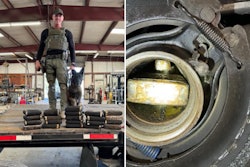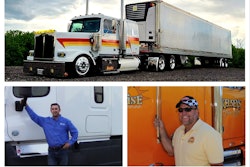
Much like the freight market in recent years, the used truck market has seen dramatic ups and downs.
Supply chain challenges during the COVID-19 pandemic threw the used truck market out of whack because production of new trucks was slowed considerably. With new trucks hard to come by, fleets and owner-operators who typically replaced their trucks every few years had to hold onto trucks longer than they’re used to.
This drove prices of used equipment through the roof, leading to a peak in April 2022. Steve Tam, vice president at ACT Research, said used prices averaged around $90,000 at the peak across the three main channels of sales -- retail, auction and wholesale. The retail market saw prices averaging over $100,000, and younger used trucks (2-3 years old) could be found selling for more than new trucks.
Since that peak 18 months ago, new truck production has returned to normal levels, and used pricing has fallen considerably, flipping the used market from a sellers’ market to a buyers’ market, with caveats.
“When freight rates were high, it attracted new drivers and companies,” Tam said, which dried up used inventories. “Eventually, most of the supply chain constraints got addressed, and the flow of new trucks got going, trades were going, and inventory was going to the secondary market.”

[Related: Truck costs likely to skyrocket in coming years]
According to ACT’s latest "State of the Industry: U.S. Classes 3-8 Used Trucks" report, used truck prices across all sales channels in September averaged $39,200.
Prior to the pandemic at the end of 2019, Tam said used trucks across all channels and all ages averaged around $30,000. Adjusted for inflation, that'd be around $36,000 today.
Tam said he believes used pricing will fall a bit more before bottoming out, but he said he expects prices to “hang on and stay at about that prior cycle low,” adjusted for inflation.
Daniel Hughes, a retail sales consultant with Arrow Truck Sales, said used inventories are strong, and prices have come down considerably in the last two years.
“There’s not a shortage of trucks like during COVID,” he said. “Trucks are back on the market.”
Hughes said he believes used trucks “are about as low as they’re going to get right now. It’s a good time to buy if you’re in a good situation.”
J.D. Power’s monthly "Commercial Vehicle Guidelines" report released in October showed used prices at auction in September were roughly at the midpoint between 2018 and 2019 levels. The newest model years available in the marketplace are about even with the strong pre-pandemic period of 2018 in nominal figures, or just more than 20% less if adjusted for inflation, the firm noted.
On the retail side, J.D. Power noted a spike in the number of 2022 model year trucks sold in September, which skewed average prices higher. Even still, the average sleeper tractor retailed in September was 67 months old, had 416,680 miles and brought $71,681. Compared with August 2023, this average sleeper was four months newer, had 31,872 (7.1%) fewer miles and brought $7,115 (11%) more money.
Compared with September 2022, the average sleeper was two months newer, had 20,080 (4.6%) fewer miles and brought $33,266 (31.7%) less money.
About two months ago, small fleet owner John Henderson bought two used trucks from a national dealership that were somewhat close to that average age -- and price, for that matter. The units were a 2019 Peterbilt 567 and a 2019 Kenworth T680. Henderson's eight-truck fleet hauls fuel and ethanol leased to Canton, Missouri-based Transport Delivery Company.
His story illustrates not only the state of the used market but, crucially, the importance of due diligence on any big equipment investment.
Don't let price alone sway you to purchase
Before buying the trucks, Henderson did some research into them and found there had been an issue with certain Paccar engines, including the 2019 model year, in which the camshafts were failing. Knowing this going into negotiations, he asked the dealer about the inspections they had done on the trucks and was told more than once that everything, including the engines, had been inspected.
He moved forward with the purchases, taking the dealer's word for it -- the purchases were completed two to three weeks apart. About a month after buying the Peterbilt, the engine failed -- and yes, the failure was due to a camshaft issue.
"I got a hold of the salesperson and told him what was going on, and I said I wanted to see the inspection reports," Henderson said. "To this day, I still haven't gotten them."
Eventually, Henderson said his salesperson came clean -- the engine inspection was not done.
"I'm not trying to say [the dealer] is totally to blame," he said. "I get it that, in the end, I bought a used truck. If they had told me up front they had not done the engine inspection, I would have told them, 'When you get one done, let me know,' because I know there were problems with the engines."
Paccar is replacing the engine, but the warranty on the engine only covers "major components," Henderson said. When the engine failed, it dropped the No. 6 intake valve, which sent parts flying inside the engine, doing additional damage to the turbo, which the warranty didn't cover. Because of this, Henderson is still on the hook for about $18,000.
 Overdrive readers have a revamped tool at their disposal for evaluating a used truck's history (including prior crash involvement, inspections, title anomalies, and more) in the updated, easy-to-use RigDig Truck History Report. It's now housed on OverdriveOnline.com via this link for single-report access.
Overdrive readers have a revamped tool at their disposal for evaluating a used truck's history (including prior crash involvement, inspections, title anomalies, and more) in the updated, easy-to-use RigDig Truck History Report. It's now housed on OverdriveOnline.com via this link for single-report access.
[Related: Given sky-high repair costs, used-truck warranties more valuable than ever]
If he had the purchases to do over again, Henderson said he would have made sure to ask the dealer to provide the inspection reports to prove they did what they said they did.
After pre-pandemic highs, used trucks today can look plenty attractive for low miles and age -- and price, of course. ACT Research's Steve Tam puts miles/age differences in perspective.
Today, he said, the average age of used trucks being sold is around 7 years, give or take, with plenty available at the approximate, attractive 4-5-year age in which Henderson invested. In December 2022, however, that average had climbed to 104 months -- almost 9 years. At the same time, miles had ticked up "to a degree, but not as much as age did,” Tam said.
At the end of 2022, average miles on used trucks sold was around 500,000. That has since fallen to around 475,000 miles.
In short, the used market's come a long way from astronomical COVID-era highs when it comes to pricing, with more and better deals available on younger rigs with fewer miles. For owner-operators looking to buy, that might be a single bright spot in what's otherwise been an exceedingly difficult set of circumstances for freight, rates and fuel costs, impacting income negatively. As Henderson's situation illustrates, though, don't neglect due diligence on any rig you're looking at.
[Related: Owner-ops navigate rocky truck parts-procurement landscape]
Used truck financing more difficult in a down market for freight
The bad news? If you aren’t paying with cash, securing financing is as challenging as it’s ever been.
Tam said in a rates environment like what was seen in late 2020 into the first part of 2022, more lending institutions get involved in trucking because there is money to be made. When conditions turn around and get tough, however, those institutions go somewhere else.
“There is less money available for truckers to borrow, and the money that is available gets more expensive” in the form of higher interest rates. “The same thing happened this time around,” he added.
[Related: Do owner-operators need to worry about credit scores?]
Chris Grivas, president and CEO of CAG Truck Capital, likewise noted an influx of lenders in 2021 and 2022, but said they’re now “shying away” from lending money in trucking.
When freight rates were high, large numbers of new owner-operators came into the business “not understanding today’s engines and life expectancy, starting out with trucks with higher mileage” and financing them beyond the expected life of the engine, Grivas said. Growing repos of trucks needing engine overhauls but also with large monthly payments still left to be made have been the result.
“I think that’s the fallout,” he said. “Rates are down, especially for newer [owner-operators] that don’t know how to bob and weave” in the freight market. “The smaller guy fell out, hence the repos.”
Today's lending environment is tilted particularly hard against the startup. “It’s tougher than ever to get financed," Grivas said. "You have finance companies that financed trucks for well over 75% of what they should have” in 2021 and 2022. Those trucks in some cases are now either being sold or repo’d.
He added that CAG has “always had the philosophy of financing a truck to the life expectancy of the engine,” noting that that’s even more so the case today. He encourages owner-operators buying used trucks to take on the biggest monthly payment they can handle in order to pay the truck off as soon as possible. When it does inevitably need an engine overhaul, thus, it's more like the rig can either be traded or the loan can be refinanced to include the overhaul.
Arrow Truck Sales’ Hughes noted that he’s seeing interest rates today on used truck financing as low as 10-11% for buyers with good credit and business history, up to 20% or more on the high end for those with poor credit, with the average falling somewhere between 14% and 17%.
Owner-operator Henderson, who has built a relationship through the years with his local Commerce Bank branch, financed his two most recent trucks in late August and early September at an 8.5% interest rate. He said the lower rate is the result of working with people he's already built relationships with and who know him and his business.
[Related: With borrowing costs up, use financing relationships, experience to advantage]
Grivas said CAG looks beyond credit scores to determine if it wants to do business with an owner-operator. He said his reps will interview a prospective buyer seeking financing to learn more about the owner-op's character, roots in the trucking business, and resourcefulness.
“This is key, being resourceful,” he said. “If you don’t know how to change a tire on a Toyota Camry, you shouldn’t be driving an 18-wheeler.”
During his 39 years in the business, Grivas said that he has “never once seen an LLC drive a truck or a credit score drive a truck.” Just because someone has an 800 credit score doesn’t mean they should own a truck, he added. Before lending money, he wants to see that the trucker has good character and knows his or her way around the business, and that they can handle certain maintenance issues that inevitably arise.
His advice to owner-operators today in the used market -- “buy a truck with under 500,000 miles, don’t finance it for more than 30 months, and put at least 25% down.”
Finally, he said, “finance with a company that will back you up when the day comes that you need an overhaul.”
[Related: RigDig Truck History Report now part of Overdrive]











